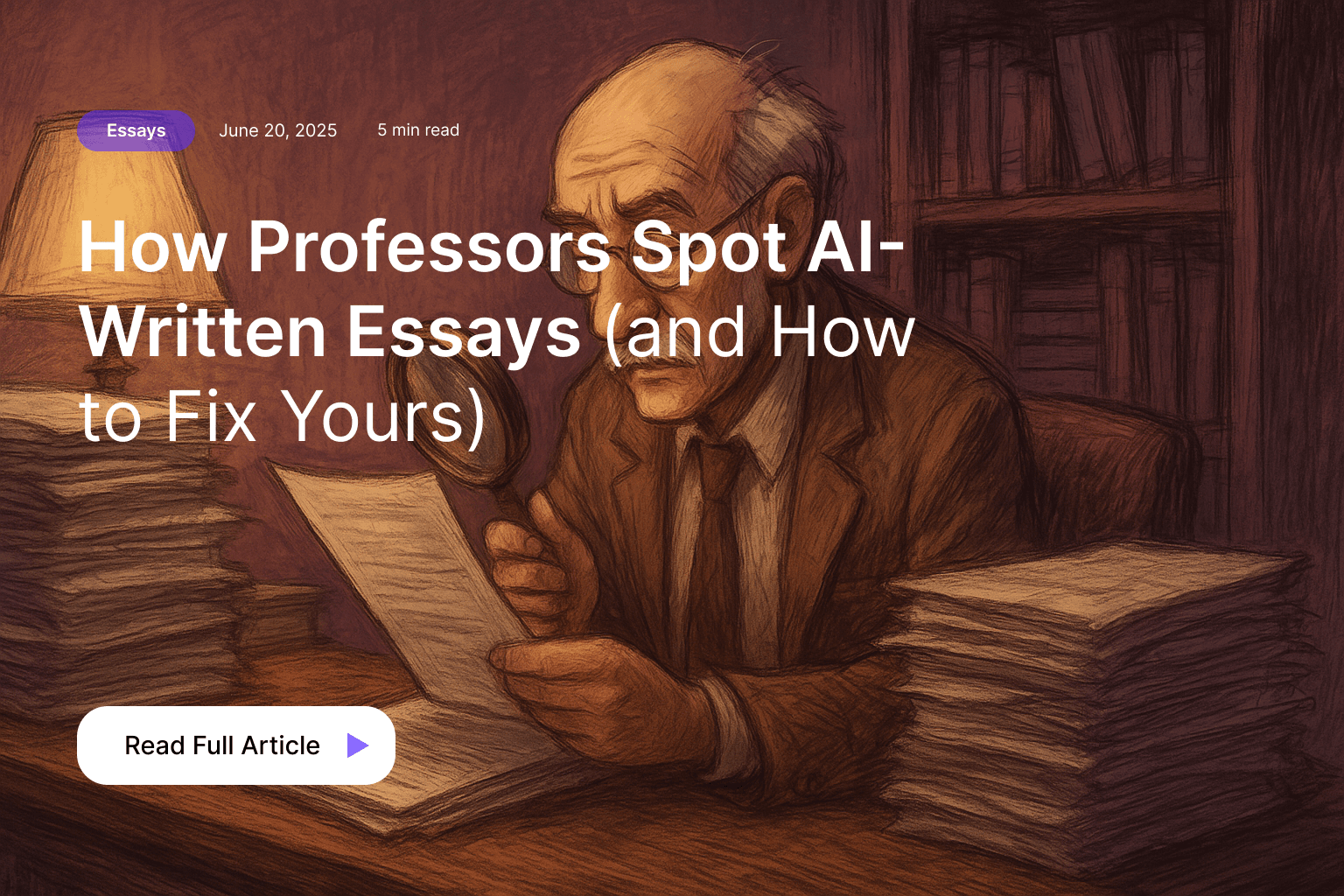If you’ve ever spent hours swapping out simple words for longer ones , “use” for “utilize,” “help” for “facilitate”, hoping your essay would sound more academic, you’re not alone.
But here’s the secret every good writer eventually learns: clarity earns more points than vocabulary ever will.
Professors aren’t impressed by how many advanced words you know; they’re impressed by how smoothly your argument moves from one idea to the next.
That smoothness, that invisible glue that holds your essay together, is what we call flow.
In this post, we’ll break down how to fix essays that feel choppy, overcomplicated, or stiff. We’ll look at what real “academic flow” means, how to rewrite your work for rhythm and readability, and how AI-based tools like Essaytone can help refine your writing without making it sound robotic.
1. Why “big words” don’t equal better grades
It’s easy to assume that academic writing is about sounding smart.
But most professors can tell when you’re writing at them instead of to them.
Here’s what actually happens when you force in complicated words:
- Your sentences become longer, not clearer.
- Your reader needs to pause to decode your meaning.
- The argument loses momentum.
Example:
Overwritten: “The preponderance of evidence unequivocally suggests a significant correlation between socioeconomic determinants and educational attainment."
Rewritten: “Most evidence shows a strong link between income and education levels.”
The second version sounds confident, not simplistic. It flows because the reader’s brain doesn’t have to stop and translate. That’s the foundation of an A+ essay, one that’s easy to follow, not hard to admire.
2. What “flow” really means in an essay
Flow isn’t a buzzword. It’s the psychological experience of reading a text that feels effortless.
When an essay flows, readers don’t notice your grammar or word choice, they only feel your argument pulling them forward.
A well-flowing essay has:
- Logical order – Each paragraph builds naturally from the one before.
- Rhythmic sentences – A mix of long and short sentences that sound alive.
- Smooth transitions – Words and phrases that connect thoughts without feeling forced.
- Clarity of purpose – Every paragraph has a reason to exist.
Flow isn’t decoration, it’s structure.
You earn it through rewriting, not thesaurus-hunting.
3. How to tell if your essay doesn’t flow
You’ll know your essay lacks flow if you spot any of these:
- Each paragraph feels like a new topic rather than a continuation.
- You have abrupt jumps between ideas (no transitions or explanations).
- Sentences all look the same length.
- You reread your own work and get lost halfway through.
- You rely on “filler” connectors: Furthermore, Moreover, In conclusion… every paragraph.
When this happens, it’s not your thinking that’s wrong, it’s your phrasing and pacing.
That’s exactly what rewriting solves.
4. The rewrite mindset: clarity first, elegance second
Most students edit by adding more. Professionals rewrite by removing clutter.
Here’s how to adopt that mindset:
| Problem | Fix | Why it helps |
|---|---|---|
| Long sentences with multiple clauses | Break into two shorter ones | Improves rhythm and readability |
| Overuse of linking words (“therefore,” “thus”) | Use natural connectors or re-order sentences | Creates smoother transitions |
| Too much passive voice | Replace with active phrasing | Builds momentum |
| Abstract words (“factors,” “aspects”) | Replace with concrete examples | Adds credibility |
Rewriting is not about cutting meaning but about revealing it faster.
5. The anatomy of a smooth paragraph
Let’s dissect what a flowing paragraph looks like.
Example A (stiff):
“Globalization has been widely discussed by scholars for decades. It is important for economic growth. However, it also has disadvantages. Therefore, policymakers must find balance.”
The ideas are fine, but the rhythm is flat, each sentence stops abruptly.
Example B (rewritten):
“For decades, scholars have debated whether globalization fuels growth or deepens inequality. It has undeniably opened markets but not evenly. Policymakers now face a tougher task: managing integration without leaving communities behind.”
Same content, better pacing.
Notice the alternation of sentence length, the natural transitions (but not evenly), and the flow that invites you to keep reading.
That’s what rewriting for clarity achieves.
6. How to build flow in your own writing
a) Write fast, rewrite slow
Your first draft should chase ideas, not perfection. Flow happens in revision, when you step back and connect those ideas logically.
b) Use “echo transitions”
Repeat a key word or phrase from the previous paragraph in your next one.
Example:
“Technology changes how we learn. That change also affects how we evaluate knowledge.”
The repetition guides the reader’s brain seamlessly.
c) Vary your sentence rhythm
Mix short, impactful lines with longer, descriptive ones.
Reading your essay out loud is the best flow test, if you lose your breath, cut it shorter.
d) End paragraphs with a hook
The last line of each paragraph should invite the next idea.
Example:
“But clarity isn’t just about structure, it’s about tone.”
That line tempts the reader to continue.
7. How AI can help you rewrite for flow (without losing your voice)
Most editing tools fix grammar and not rhythm.
But modern AI academic rewriters can help identify robotic patterns, sentence repetition, or overly formal phrasing, and rewrite them in natural academic language.
Here’s how to use them effectively:
Step 1: Input your full draft
Paste your essay into Essaytone’s AI-to-Human Rewriter. It analyzes sentence rhythm, coherence, and tone consistency.
Step 2: Review rewritten sections
Essaytone doesn’t “spin” your text. It rewrites to improve clarity and natural flow, shortening, reorganizing, and simplifying while keeping your ideas intact.
Example:
Before: “It is evident that climate change policies require immediate and significant attention from world leaders.”
After: “Climate change policies demand immediate attention from world leaders.”
Cleaner. Direct. Natural.
Step 3: Keep your own rhythm
Accept only suggestions that sound like you.
The best essays sound human, not algorithmic, which is exactly the balance Essaytone is designed for.
8. The science behind readability (and why flow wins marks)
In readability studies, the more “cognitive friction” a reader feels, the less they retain.
Professors may not use that term, but they feel it: if your essay takes effort to read, it feels weaker, even if your ideas are strong.
Flow helps readers understand structure, emphasis, and cause-effect logic quickly. That translates to higher grades for clarity, organization, and argument strength, the same categories on most grading rubrics.
A+ essays aren’t about showing intelligence; they’re about transmitting it smoothly.
9. Rewrite example: from stiff to flowing
Before:
“In the modern world, communication technology has improved rapidly. It has changed the way people interact. However, there are also negative impacts such as addiction and misinformation.”
After (rewritten with flow):
“Modern communication tools have reshaped how we connect instantly, globally, and constantly. But this convenience comes with a cost: distraction, dependency, and a blurred line between real and virtual truth.”
Notice how the rewritten version moves like speech, it has pauses, emphasis, rhythm, and imagery. That’s flow.
10. The hidden confidence effect
When your essay flows, something else happens: you sound confident.
Clarity feels like authority. Professors sense when a writer knows what they’re talking about because every sentence moves with purpose.
You don’t need to use complicated phrasing to sound intelligent.
You just need to control the pace of your reader’s understanding.
11. The rewriting formula you can follow
Next time you edit your essay, use this quick checklist:
| Step | Focus | Question to ask |
|---|---|---|
| 1 | Structure | Does each paragraph logically follow the previous? |
| 2 | Clarity | Can I say this in fewer words? |
| 3 | Rhythm | Do my sentences vary in length? |
| 4 | Transitions | Is there a natural bridge between ideas? |
| 5 | Tone | Does it sound like me, not a robot? |
That’s it. Flow isn’t about perfection, it’s about pacing and clarity.
12. Flow is the new “academic polish”
Ten years ago, academic writing rewarded complexity.
Now, clarity and communication skills matter more, especially with AI-generated writing flooding the web.
Readers (and graders) are drawn to text that feels alive.
So when you rewrite, don’t chase fancy vocabulary. Chase readability.
Because when your essay reads effortlessly, it’s already smarter than half the class.
A+ essays don’t come from thesauruses, they come from flow.
From sentences that breathe. From paragraphs that build.
From arguments that read like thought, not formula.
If you want your writing to sound human, structured, smooth, and confident - don’t overcomplicate it. Rewrite it clearly. Edit for rhythm. Let it move.
And if you need help transforming your draft into natural academic language, Essaytone was built exactly for that.




